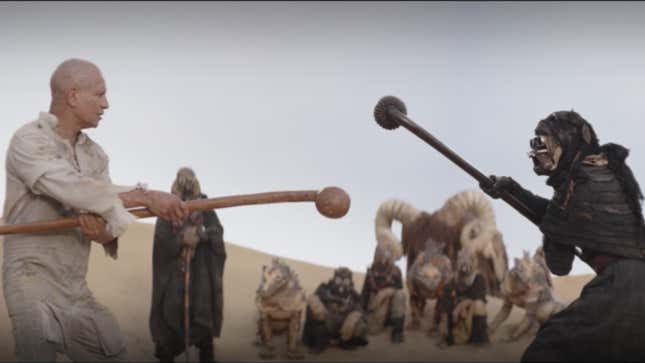
It turns out the Tuskens are a complicated people. The native Tatooinians typified as evil savages in the early Star Wars films have been revealed to be so much more, thanks to TV series The Mandalorian and The Book of Boba Fett. While it’s both fantastic and necessary to see cultural depth given to an indigenous people, even a fictional one, this retcon is having one unfortunate side effect.
I speak, of course, of the scene in Attack of the Clones where Anakin discovers his mother Shmi has been captured by a tribe of Tuskens, finds her only to have her die in his arms, and then murders every single Tusken there. “I killed them, I killed them all. They’re dead. Every single one of them. But not just the men, but the women, and the children too,” he states to Padmé when he returns to his stepdad’s homestead.
It was already an awkward scene when Attack of the Clones premiered back in 2002; while it’s clear director George Lucas wanted to use it to portray the anguish and anger that would eventually lead Anakin to the Dark Side in Revenge of the Sith, the pointed slaughter of the children feels like an extremely unnecessary step too far at this mid-point in Anakin’s character arc. (All this is to say nothing of how Padmé hears this confession and still finds him a viable marriage partner at the end of the movie.)
Having a group of Tuskens needlessly capture and torture Anakin’s mom is only the most glaring of their portrayals as uncivilized brutes. Right from the beginning, A New Hope introduces them as ululating marauders who attack Luke and pilfer through his landspeeder. They take potshots at the podracers in The Phantom Menace. The Tuskens were presented as monstrous bad guys, to be given no more consideration as people than the Empire’s faceless Stormtroopers. And perhaps worse, since the only reason they assault Shmi is as a narrative tool to give Anakin conflict and propel him on his emotional journey.
This version of the Tuskens hasn’t aged well, and would merit a lookback and reassessment even if the Disney era of Star Wars hadn’t already been going out of its way to preemptively rebrand them. In The Mandalorian’s first season, Din Djarin is able to communicate with them via sign language to safely travel through their land. In the Aftermath: Empire’s End novel, Freetown marshal Cobb Vanth manages to negotiate a deal with them to protect his town in exchange for water, and the Tuskens even liberate Freetown after a group of slavers capture it. In The Mandalorian season two, Din and Cobb team up with those same Tuskens to defeat an enormous Krayt dragon. There’s no kidnapping, there’s no barbarity—just two very different cultures, working together.
Of course, The Book of Boba Fett has done the most to redefine the Tuskens. Although a tribe captures the unconscious Fett after he escapes the Sarlacc pit, they eventually let him become a full member, with all the ritual and honor that entails. Fett later says that there are many different tribes of Tuskens, each with their own sets of values (likely to help justify the Shmi situation). As the ex-bounty hunter spends more and more time with them, the Tuskens are revealed to be made up of unique individuals united under their unique culture. For lack of a better term, The Boba of Fett has proven without a doubt that the Tuskens were “real people.”
This is great and smart and overdue, so kudos to Lucasfilm for recognizing the problem on its own and addressing it. There’s just one problem—not a big problem, and certainly one worth creating—and that is now I feel super, super-uncomfortable about Anakin slaughtering all those Tuskens in Attack of the Clones.
Again, it was always an uncomfortable scene, but now it’s so much worse because it feels like less of an act of vengeance and more like a hate crime? Sure, narratively, it still makes sense that having his mom die in his arms would send Anakin into a berserker rage. But now, knowing the complexity of the Tuskens as a whole and as individuals, it’s impossible not to see the scene as Anakin killing an entire cultural group of people for the crimes of just a few. Even assuming kidnapping and torturing people is part of this particular tribe’s values, there are only so many members of the tribe who could be responsible for Shmi’s death. If nothing else, the women and children were almost certainly guilt-free, and yet Anakin goes out of his way to specify yep, he slaughtered them, too.
Look, I’m well aware Anakin killed a ton of people in Revenge of the Sith, including another gaggle of children, so he was an equal opportunity murderer by the end. But that’s completely irrelevant when I think about the brief glimpse we see of him attacking the Tuskens in Clones, along with the petulant confession he makes to Padmé. It’s a step too far into the real-world horrors that I have absolutely no desire to confront when watching Star Wars. Honestly? It’s just… icky.
Again, I do think it’s a good thing Tuskens aren’t just portrayed as homogenized savages anymore. But I do think it’s worth noting that sometimes even good retcons can have consequences that weren’t necessarily foreseen. I guess the silver lining here is that I rarely have any desire to rewatch Attack of the Clones in the first place.
Wondering where our RSS feed went? You can pick the new up one here.